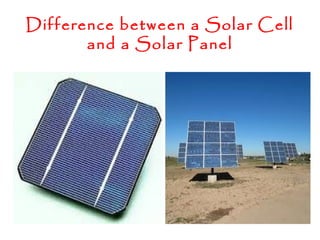
Difference of a solar cell a solar panel
- 1. Difference between a Solar Cell and a Solar Panel
- 2. Solar Cells
- 3. A solar cell (also called a photovoltaic cell) is an electrical device that converts the energy of light directly into electricity by the photovoltaic effect. It is a form of photoelectric cell (in that its electrical characteristics—e.g. current, voltage, or resistance—vary when light is incident upon it) which, when exposed to light, can generate and support an electric current without being attached to any external voltage source. The term "photovoltaic" comes from the Greek φ ς (ῶ phōs) meaning "light", and from "Volt", the unit of electro-motive force, the volt, which in turn comes from the last name of the Italian physicist Alessandro Volta, inventor of the battery (electrochemical cell). The term "photo-voltaic" has been in use in English since 1849. Photovoltaics is the field of technology and research related to the practical application of photovoltaic cells in producing electricity from light, though it is often used specifically to refer to the generation of electricity from sunlight. Cells can be described as photovoltaic even when the light source is not necessarily sunlight (lamplight, artificial light, etc.). In such cases the cell is sometimes used as a photodetector (for example infrared detectors), detecting light or other electromagnetic radiation near the visible range, or measuring light intensity. The operation of a photovoltaic (PV) cell requires 3 basic attributes: The absorption of light, generating either electron-hole pairs or excitons. The separation of charge carriers of opposite types. The separate extraction of those carriers to an external circuit. In contrast, a solar thermal collector collects heat by absorbing sunlight, for the purpose of either direct heating or indirect electrical power generation. "Photoelectrolytic cell" (photoelectrochemical cell), on the other hand, refers either a type of photovoltaic cell (like that developed by A.E. Becquerel and modern dye-sensitized solar cells) or a device that splits water directly into hydrogen and oxygen using only solar illumination.
- 4. Solar Panels
- 5. A solar panel (also solar module, photovoltaic module or photovoltaic panel) is a packaged, connected assembly of photovoltaic cells. The solar panel can be used as a component of a larger photovoltaic system to generate and supply electricity in commercial and residential applications. Each panel is rated by its DC output power under standard test conditions, and typically ranges from 100 to 320 watts. The efficiency of a panel determines the area of a panel given the same rated output - an 8% efficient 230 watt panel will have twice the area of a 16% efficient 230 watt panel. Because a single solar panel can produce only a limited amount of power, most installations contain multiple panels. A photovoltaic system typically includes an array of solar panels, an inverter, and sometimes a battery and or solar tracker and interconnection wiring.
- 7. Crystalline silicon modules Most solar modules are currently produced from silicon photovoltaic cells. These are typically categorized as monocrystalline or polycrystalline modules.
- 9. Thin-film modulesThird generation solar cells are advanced thin-film cells. They produce high- efficiency conversion at low cost.
- 11. Rigid thin-film modulesIn rigid thin film modules, the cell and the module are manufactured in the same production line. The cell is created on a glass substrate or superstrate, and the electrical connections are created in situ, a so-called "monolithic integration". The substrate or superstrate is laminated with an encapsulant to a front or back sheet, usually another sheet of glass. The main cell technologies in this category are CdTe, or a-Si, or a-Si+uc-Si tandem, or CIGS (or variant). Amorphous silicon has a sunlight conversion rate of 6-12%.
- 13. Flexible thin-film modules Flexible thin film cells and modules are created on the same production line by depositing the photoactive layer and other necessary layers on a flexible substrate. If the substrate is an insulator (e.g. polyester or polyimide film) then monolithic integration can be used. If it is a conductor then another technique for electrical connection must be used. The cells are assembled into modules by laminating them to a transparent colorless fluoropolymer on the front side (typically ETFE or FEP) and a polymer suitable for bonding to the final substrate on the other side. The only commercially available (in MW quantities) flexible module uses amorphous silicon triple junction (from Unisolar).
- 15. Solar micro- inverterSeveral companies have begun embedding electronics into PV modules. This enables performing maximum power point tracking (MPPT) for each module individually, and the measurement of performance data for monitoring and fault detection at module level. Some of these solutions make use of power optimizers, a DC- to-DC converter technology developed to maximize the power harvest from solar photovoltaic systems. As of about 2010, such electronics can also compensate for shading effects, wherein a shadow falling across a section of a panel causes the electrical output of one or more strings of cells in the panel to fall to zero, but not having the output of the entire panel fall to zero.
